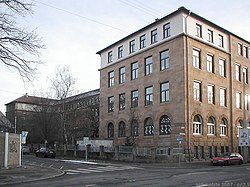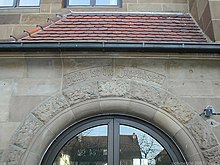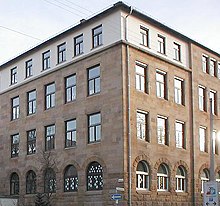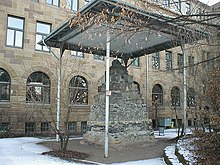Dam School (Heilbronn)
| Damm Primary School Heilbronn Damm Realschule Heilbronn |
|
|---|---|

|
|
| type of school | Elementary school / secondary school |
| founding | 1908 |
| address |
Dammstrasse 14 |
| place | Heilbronn |
| country | Baden-Württemberg |
| Country | Germany |
| Coordinates | 49 ° 8 '50 " N , 9 ° 13' 11" E |
| carrier | City of Heilbronn |
| management | Mr. Siwior (secondary school) |
| Website | drs-hn.de |
The Dammschule is a school building at Dammstrasse 14 in Heilbronn , which today houses a primary school ( Dammgrundschule Heilbronn ) and a secondary school ( Dammrealschule Heilbronn ). The building, like Dammstrasse, was named after the dam that was in the immediate vicinity of the school. The original name collective school building for elementary schools and dam schools on Dammstraße was relatively bulky, which is why people used to speak of the so-called dam schools.
Heilbronner city architect Heinrich Arnold (1858-1917), closest collaborator and since 1903 the successor to the municipal architect Gustav Wenzel , built next to the Heilbronner gasworks and Rosenau school and the dam school. The school building was inaugurated in 1908 after two years of construction, survived the Second World War and has been renovated several times. In 1971 a new gymnasium was built in the schoolyard of the secondary school, and in 1986 the secondary school received a new building with specialist rooms for technology, art and music. The geology pyramid, completed in 1912, is located in the schoolyard .
School history
prehistory
The Heilbronn secondary schools go back to 1873, when the secondary classes were separated from the Karlsgymnasium (today's Theodor-Heuss-Gymnasium ). In 1889 the secondary school moved into a building on Bismarckstrasse. In 1905 classes were added, in 1906 the lower six classes were branched off as Damm Realschule.
Heilbronn was the second largest industrial city in Württemberg at the beginning of the 20th century. Due to immigration and the strong population growth, the number of residents rose rapidly. In view of the associated rapidly growing number of pupils - the number of Heilbronn pupils rose from 1,500 in 1873 to 4,200 in 1908 - the civic committee decided to build another school building in 1905 after the Rosenau School had only been inaugurated in 1900 .
Elementary and secondary school, club hospital and Swiss aid
The collective school building for elementary and secondary schools on Dammstraße (the so-called Dammschulen ), built according to plans by Heinrich Arnold, was inaugurated on September 17, 1908. At that time, seven boys 'primary school classes with 328 students, 16 girls' primary school classes with 834 students and eight real classes with 280 students moved into the new building. Prelate v. On the occasion of the inauguration ceremony, Wunderlich said: "May this dam school become a place of blessing, a dam against everything mean and bad, a refuge for everything that is true and good."
In 1911 and 1912, the geological Triassic pyramid was built on the forecourt of the dam school under the direction of senior high school teacher Gotthold Stettner . During the First World War, the Red Cross set up one of four club hospitals in the school in 1915. In 1918 the school was completely shut down due to a flu epidemic and the building was only used as a military hospital and a military hospital.
From February 22, 1924 to May 31, 1924 and from December 3, 1924 to March 3, 1925, during a famine, Swiss Aid was serving soup not only in the Moltkekaserne and the Protestant youth home on the corner of Klara- / Wollhausstraße but also in the schoolyard of the Dammschule. In addition, clothing was distributed there for the needy population.
In 1924 the Realschule was renamed to Boys' Middle School. During the Nazi era, the boys' middle school was combined with the humanistic Karlsgymnasium to form the Karls-Oberschule.
post war period
The dam school survived the air raid on Heilbronn in December 1944, but with a burned-out attic. The largely undamaged lower floors were used as a prisoner-of-war camp from 1945 and as a refugee, care and health center from 1945 to 1948. The building was rebuilt from 1947 to 1948 and the attic was expanded. In December 1948, the girls' high school moved into the Dammschule. The dam school was re-inaugurated on October 12, 1949. In 1949, the Heilbronn Girls' Middle School was able to share the rooms of the Dammschule with the middle school for boys and some high school and elementary school classes.
In 1954, when a group of around 40 students from Heilbronn secondary school was staying in the Dachstein Mountains, the Dachstein tragedy occurred in which 13 people were killed.
In 1961 pupils of the Dammschule from the first to the fourth grade attended the pavilion school , which was inaugurated on May 30, 1961 as a primary school at Karlstrasse 145-147 in Heilbronn.
Since 1966, the boys' middle school was again called Realschule, but remained a Realschule reserved for boys. On July 9, 1966, the Damm high school students demonstrated against the increase in the price of pretzels from 10 to 15 pfennigs. In July 1970, the Dam School Girls and the Dam School Boys were combined under one school management.
In 1971 a new prefabricated sports hall was built on the playground of the Dammrealschule within just five months at a cost of around one million DM.
In 1971 the Dammschule only had the Dammgrundschule and the Dammrealschule, the secondary school has been spun off since then. Since 1979/1980 boys and girls have been taught co-educational at the Dammrealschule .
The school building was renovated and expanded in 1986.
In 1996, pupils, parents and teachers from Dammrealschule got involved in the pilot project Eco-Audit and School . The energy consumption in the heating and electrical sectors as well as the amount of waste were examined with a view to possible savings. In 1998 the Dammrealschule was the first Realschule in Germany to be certified with an EU Eco Audit ( EMAS regulation ). Since then, there have been environmental speakers in every class in the Dammrealschule.
21st century
On December 16, 2004, the local authority decided to expand the Damm elementary and secondary schools into all-day schools in the medium to long term, because both schools have had to work under increasingly difficult social and educational conditions for years. Therefore, the expansion project was included in the priority list for school building. The Realschule has not yet introduced an all-day offer. The establishment of an all-day school at the Damm Primary School had to be suspended in 2006 due to personnel shortages and was only partially implemented in the 2008/2009 school year: So far, the Damm Primary School has not been able to offer a warm lunch and there are not all-day care places for all pupils.
In the 2007/2008 school year, students of 27 nationalities were represented at the Damm Primary School. The proportion of foreigners was 52%, another 18% of the students come from ethnic German repatriate families. At the Dammrealschule, the proportion of foreign students, at 44.5%, is around twice as high as the average of all secondary schools in Heilbronn. Both schools support students with a migration background. In addition to offers for all pupils, special support classes have been set up: The Damm Primary School has two preparatory classes and one support class, the Damm Realschule two support classes. A school social worker works at both schools.
In the anniversary year 2008, numerous school celebrations took place. In addition, the Dammrealschule concluded cooperation agreements with EnBW, Bierstorfer XXXL and Aldi Süd in 2008 and celebrated the year of mathematics with a performance by the magician of numbers.
In 2008, Damm Primary School attended 416 students in 19 classes; the average class size was 22 students. In 2008 the Dammrealschule was attended by 485 students in 20 classes, the average class size was 24 students.
architecture
The layout of the four and a half-story sandstone building is U-shaped, the stairwells as risalits emerge from the facade and the lower floors a Rustika have. The green area of the dam school was included in the renovation of the northern part of the city.
Geology pyramid
In the schoolyard there is a geological pyramid created by Gotthold Stettner in 1912 , which shows the geological layer structure of the Heilbronn area and is made up of the rocks of the Triassic . The base consists of differently processed red sandstone . The pyramid contains numerous fossils from the animal and plant kingdom. The salt deposits of the shell limestone are indicated by glass, Keuper layers by colored stripes. The different design of the four sides of the pyramid partly takes into account the different geological conditions of the country. The top of the pyramid is a petrified ammonite . In the course of the redesign of the school yard, the aging roof of the geology pyramid was removed in summer 2008.
Motto
The school's motto is: Young people are sacred . The saying can be read over one of the portals to the schoolyard. Above another entrance gate is written: Strive for being, not for appearance .
Well-known former teachers and students
- Carl Rudolf Bertsch , painter and writer, former art teacher at the dam school
- Friedrich Löchner , poet, author, chess player, former teacher and from 1966 to 1979 rector of the Dammrealschule
- Walter Maisak , artist
- Dieter Schwarz , entrepreneur and honorary citizen of the city of Heilbronn
- Karl-Eugen Kurrer , civil engineer and structural engineering historian
References and comments
- ↑ school management. Retrieved March 17, 2020 .
- ↑ Festschrift 100 years of dam schools (see literature), p. 12.
- ↑ Lattner / Hennze, p. 45
- ↑ Festschrift 100 years of dam schools (see literature), p. 25f.
- ↑ Festschrift 100 years of dam schools (see literature), p. 11
- ↑ Lattner / Hennze, p. 53
- ↑ Jacobi, 2001, p. 12
- ↑ Festschrift 100 years of dam schools (see literature), p. 12f.
- ↑ Festschrift 100 years of dam schools (see literature), p. 12
- ↑ Festschrift 100 years of dam schools (see literature), p. 13f.
- ↑ Jacobi, 2001, p. 19
- ↑ Festschrift 100 years of dam schools (see literature), p. 15
- ↑ Schmolz / Weckbach, p. 152, No. 504
- ↑ Festschrift 100 years of dam schools (see literature), p. 18f.
- ↑ Jacobi, 2001, p. 52
- ↑ June 1951: Inauguration of the girls' middle school . In: Heilbronner Voice of June 20, 1961, No. 138, p. 3
- ^ Jacobi, 2001, p. 58
-
↑ Article in Heilbronner Voice , May 31, 1961, No. 123, p. 3: First day of class in the pavilion school
"- the ABC-Schützen - by the way, it is a mixed class - and a second class administratively belong to the dam school girls, two third and a fourth class belong to the rectorate of the dam school boys."
-
↑ Heilbronner Voice , article from October 7, 1961, title An "oasis of calm" on the outskirts of the city
“[...] Five classes have found [...] a school home in the new school; two third and fourth grades from Dammschule boys and a first and second grade from Dammschule girls. "
- ↑ Jacobi, 2001, p. 70
- ↑ Jacobi, 2001, p. 74
- ↑ Festschrift 100 years of dam schools (see literature), p. 25
- ↑ Festschrift 100 years of dam schools (see literature), p. 25
- ↑ environmental spokesman on the homepage; Accessed November 5, 2008
- ^ Gertrud Schubert: Lunch included . Also published in Heilbronner Voice on September 11, 2008
- ↑ Bernd Martin: A multicultural place of learning . In: Neckar-Express of May 14, 2008
- ^ School report of the City of Heilbronn 2007/2008. In: www.heilbronn.de. P. 41 , archived from the original on February 20, 2013 ; accessed on March 17, 2020 .
- ↑ Festschrift 100 years of dam schools (see literature), p. 63, p. 118
- ^ School report of the City of Heilbronn 2007/2008. In: www.heilbronn.de. P. 24 , archived from the original on February 20, 2013 ; accessed on March 17, 2020 .
- ↑ festival program; Accessed November 5, 2008
- ↑ cooperation agreements; Accessed November 5, 2008
- ↑ A lot of hocus-pocus with numbers , article by Stefanie Pfäffle, also published in Echo on Wednesday October 22, 2008, page 3 ( page no longer available , search in web archives ) Info: The link was automatically marked as defective. Please check the link according to the instructions and then remove this notice.
- ^ School statistics from the Baden-Württemberg Ministry of Culture
- ↑ Visit report. (pdf) (No longer available online.) In: www.johanna-lichy.de. Formerly in the original ; accessed on March 17, 2020 . ( Page no longer available , search in web archives )
- ↑ Jacobi, 1987, p. 56
- ↑ Perseverance leads to the goal , article in the Heilbronner Voice of August 29, 2000, No. 199, p. 14
literature
- Bernhard Lattner with texts by Joachim J. Hennze: Silent contemporary witnesses. 500 years of Heilbronn architecture . Edition Lattner, Heilbronn 2005, ISBN 3-9807729-6-9 .
- Uwe Jacobi: Heilbronn as it was . Droste, Düsseldorf 1987, ISBN 3-7700-0746-8 .
- Uwe Jacobi: That was the 20th century in Heilbronn . Wartberg-Verlag, Gudensberg-Gleichen 2001, ISBN 3-86134-703-2 .
- Helmut Schmolz , Hubert Weckbach: Heilbronn. History and life of a city . 2nd Edition. Konrad, Weißenhorn 1973, ISBN 3-87437-062-3 .
- Festschrift 100 years of dam schools , Heilbronn 2008


